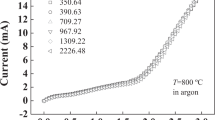Abstract
Current-voltage characteristics of limiting current-type oxygen sensors were investigated. The sensor showed a two-stage current plateau in current-voltage characteristics in H2O−O2−N2 and CO2−O2−N2 mixtures. The sensor current in the first stage corresponded to O2 concentration and was practically independent of H2O and CO2 concentration in the gas mixtures. The sensor current in the second stage increased linearly with the H2O or CO2 concentration, for a sensor with high electrode activity. The behavior of the sensor suggests that the deoxidization of H2O or CO2 occurs at the sensor cathode. For nonequilibrium gas mixtures containing combustible gas and O2, the sensor current in the first stage decreased linearly with combustible gas concentration. The decrease of the sensor current differed from that corresponding to the O2 concentration consumed by the reaction of these gases in the ambient gas, depending on the kind of combustible gas. The reduction of the sensor current is explained by a model assuming that the reaction of these gases occurs at the cathode, and the diffusion of the combustible gas in the porous coating is a rate-limiting step.
Similar content being viewed by others
References
S. Matsushita, T. Inoue, K. Nakanishi, K. Kato and N. Kobayashi, SAE Paper 850044, SAE International Congress and Exposition, Detroit Michigan, 25 Feb.–1 March 1985.
Y. Kimbara, K. Shinoda, H. Koide and N. Kobayashi, SAE Paper 851210, SAE Government/Industry Meeting and Exposition, Washington, DC, 20–23 May 1985.
H. Dietz,Solit State Ionics 6 (1982) 175.
K. Saji, H. Takahashi, H. Kondo, T. Takeuchi and I. Igarashi, ‘Proceedings of the 4th Sensor Symposium’, Institute of Electrical Engineers of Japan, Tokyo (1984) p. 147.
K. Saji,J. Electrochem. Soc. 134 (1987) 2430.
K. Saji, H. Kondo, H. Takahashi, T. Takeuchi and I. Igarashi, ‘Digest of Technical Papers' Presented at the 3rd International Conference on Solid-State Sensors and Actuators, Philadelphia, Pennsylvania, 11–14 June (1985) p. 336.
H. Takahashi, K. Saji, H. Kondo, T. Takeuchi and I. Igarashi, ‘Proceedings of the 5th Sensor Symposium’, Institute of Electrical Engineers of Japan, Tokyo (1985) p. 133.
T. Usui, A. Asada and Y. Isono, ‘Proceedings of the the 6th Sensor Symposium’, Institute of Electrical Engineers of Japan, Tokyo (1986) p. 279.
S. Pizzini, M. Bianchi, P. Colombo and S. Torchio,J. Appl. Electrochem. 3 (1973) 153.
Author information
Authors and Affiliations
Rights and permissions
About this article
Cite this article
Saji, K., Kondo, H., Takahashi, H. et al. Influence of H2O, CO2 and various combustible gases on the characteristics of a limiting current-type oxygen sensor. J Appl Electrochem 18, 757–762 (1988). https://doi.org/10.1007/BF01016904
Received:
Revised:
Issue Date:
DOI: https://doi.org/10.1007/BF01016904




